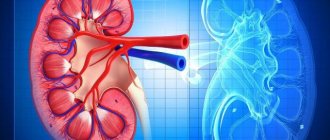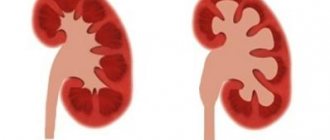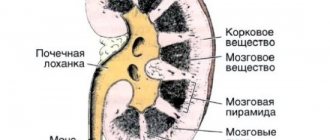Kidney dysplasia is a congenital pathology of the development of the genitourinary system, in which the internal structures of one or both kidneys of the fetus are underdeveloped in the womb.
When fully developed, thin tubes of muscle—the ureters—grow into the kidneys and branch to form a network of tiny tubules. They are responsible for collecting urine as the fetus grows in the womb.
With kidney dysplasia, the tubules cannot completely branch, and accordingly, the urine that usually flows through them has nowhere to go. As a result, it collects inside the affected kidney, forming fluid-filled sacs called cysts, which replace healthy kidney tissue and prevent it from functioning properly.
Kidney function
The kidneys are two bean-shaped organs, each about the size of a fist. They are located just below the rib cage, one on each side of the spine. Every day, the kidneys filter up to 135 liters of blood and produce approximately 0.9-1.8 liters of urine.
In children, accordingly, less urine is produced. It passes from the kidneys to the bladder through two ureters, one on each side of the bladder. As it fills, signals are sent to the brain, telling the person to go to the toilet.
Causes of kidney dysplasia
Kidney dysplasia can be caused by several reasons:
- genetic factors (an altered or mutated gene was passed on to the child);
- genetic syndromes - a set of anomalies that have the same genetic cause without any visible external relationship. Children with kidney dysplasia may also have problems with the nervous system, heart and blood vessels, digestive tract, etc.;
- if the mother took strong medications during pregnancy, for example for seizures or high blood pressure, or took drugs.
Which method of diagnosing cystic kidney dysplasia in children to choose: MRI, CT, ultrasound
What will an abdominal ultrasound show for cystic kidney dysplasia in a child?
- Multiple thin-walled cysts of various sizes
- No communication between cysts
- Absence of the calyceal renal system
- Minimal or complete absence of hyperechoic parenchyma
- Compensatory hypertrophy of the opposite kidney.
Multicystic kidney dysplasia. Ultrasound. Multiple cysts of various sizes distributed in the dysplastic tissue of the kidney.
What MRI images of the kidneys will show for cystic dysplasia in a child
- MR urography
- NASTE, RARE, true FISP: groups of cysts resembling bunches of grapes
- 3D-T1 GE-weighted images after administration of contrast agent and low doses of furosemide: visualization of the contralateral side with associated malformations
- Static and dynamic MR urography is used to assess kidney function on the contralateral side.
In what cases do children undergo scintigraphy for cystic kidney disease?
- Lack of kidney function on the affected side.
What will retrograde cystourethrography show for kidney cysts in children?
- Used to confirm or exclude concomitant vesicoureteral reflux.
Multicystic dysplasia of the right kidney and obstruction of the ureteropelvic junction on the left. ON S TE (a) and T1-weighted MR urography ( b ). Groups of multiple cysts on the right, hyperintense on NA S TE (T2-weighted image) and hypointense on T1-weighted image. Decompensated obstruction of the ureteropelvic junction causes a pronounced delay in the excretion of the contrast agent into the dilated pelvis of the left kidney.
Treatment of kidney dysplasia
If dysplasia concerns one kidney and the child does not experience any particular discomfort, then treatment may not even be necessary. However, the child should undergo regular checkups, which include:
- blood test - to measure kidney function;
- urine test for albumin - a protein, the presence of which may indicate kidney damage;
- checking blood pressure;
- regular ultrasound examinations to monitor the damaged and to check the healthy kidney.
Treatment
The need for therapeutic measures for renal aplasia arises in three cases:
• severe pain in the kidney area;
• development of nephrogenic hypertension;
• reflux into a hypoplastic ureter.
Treatment consists of performing ureteronephrectomy (removal of the kidney and ureter).
Renal hypoplasia
Renal hypoplasia is a congenital reduction of the kidney, mainly associated with early degeneration of the metanephric diverticulum or the absence of an inducing effect from the diverticulum on the metanephric blastema. The anomaly occurs with approximately the same frequency as renal aplasia.
A hypoplastic kidney macroscopically represents a normally formed organ in miniature. On its section, the cortical and medulla layers are clearly defined. However, histologically, changes are revealed that make it possible to distinguish three forms of hypoplasia: simple hypoplasia, hypoplasia with oligonephronia, and hypoplasia with dysplasia.
• The simple form of hypoplasia is characterized only by a decrease in the number of calyces and nephrons.
• With hypoplasia with oligonephronia, a decrease in the number of glomeruli is combined with an increase in the total volume of interstitial tissue and dilation of the tubules.
• Hypoplasia with dysplasia (hypoplastic dysplasia) is characterized by the presence of groups of primitive (embryonic) glomeruli surrounded by immature mesenchymal tissue. Glomerular or tubular cysts, groups of immature tubules and arterioles with a thickened wall and chaotic branching are identified; sometimes there are areas of cartilaginous tissue. This form of hypoplasia, unlike the two above, is often accompanied by abnormalities of the urinary tract.
Clinical picture
Unilateral hypoplasia may not manifest itself in any way throughout life, but a hypoplastic kidney is often affected by pyelonephritis and often serves as a source of development of nephrogenic hypertension. It is important to note that it is a hypoplastic kidney that can cause arterial hypertension in the early stages of a child’s life. Such renin-dependent forms of hypertension are often malignant in nature, and the only treatment in such cases is nephrectomy (for unilateral lesions).
Bilateral renal hypoplasia manifests itself early - in the first years and even weeks of a child’s life. Children are lagging behind in growth and development. Pallor, vomiting, diarrhea, increased body temperature, and signs of rickets are often observed. A pronounced decrease in the concentrating ability of the kidneys is characteristic. However, the data of biochemical blood tests remain normal for a long time. Blood pressure is also usually normal and increases only with the development of chronic renal failure. The disease is often complicated by severe pyelonephritis. Most children with severe bilateral renal hypoplasia die from chronic renal failure in the first years of life.
Diagnostics
Unilateral hypoplasia is usually detected by X-ray examination undertaken for pyelonephritis. Excretory urograms show a decrease in the size of the kidney with a well-contrasted collector system. The contours of the kidney may be uneven, the pelvis is moderately dilated.
With hypoplasia of the kidneys, the calyces are not deformed, as with pyelonephritis, but are only reduced in number and volume. Urograms show compensatory hypertrophy of the contralateral kidney.
Renal angiography is of great help in differential diagnosis. With hypoplasia, the diameter of the renal artery and vein is reduced by 1.5–2 times compared to the vessels of a healthy kidney; subsequent generations of vessels (segmental, interlobar) are also thinned, but can be traced to the periphery of the kidney. The nephrogram phase is expressed quite satisfactorily. With a secondarily shriveled kidney, the angiographic picture may indicate a normal diameter of the renal artery, but all subsequent arterial generations are sharply narrowed, knee-shaped, most of them are “chopped off,” and the periphery cannot be traced. The nephrogram is weak, sparse, sometimes absent.
The diagnostic value of a kidney biopsy for hypoplasia is low.
Course of unilateral renal dysplasia
Children with unilateral renal dysplasia have every chance for full development: they most likely will not experience any special health problems.
As the child grows, the affected kidney may shrink, and by age 10 it may not be visible on X-rays or ultrasounds.
Patients with one functioning kidney should be regularly screened for high blood pressure and genitourinary health.
If you have urinary tract problems that cause your kidney to stop working, you may need dialysis or an organ transplant.
Treatment
Surgeries on a horseshoe kidney are usually performed only in the presence of complications (hydronephrosis, stones, tumor, etc.). In order to identify the nature of the blood supply before surgery, it is advisable to perform renal angiography.
Biscuit bud
A biscuit-shaped kidney is a flat oval formation located at the level of the sacral promontory or below.
This anomaly is formed as a result of the fusion of two kidneys at both ends before their rotation begins. The biscuit-shaped kidney is supplied with blood by multiple vessels extending from the aortic bifurcation and randomly penetrating the renal parenchyma. The pelvis is located anteriorly, the ureters are shortened. The anomaly occurs with a frequency of 1 in 26,000 newborns.
Diagnostics
Diagnosis is based on palpation of the abdominal wall and rectal digital examination, as well as on the results of excretory urography and renal angiography.
Asymmetric forms of fusion
Asymmetric forms of fusion account for 4% of all renal anomalies. They are characterized by the connection of the kidneys at opposite ends. In the case of an S-shaped bud, the longitudinal axes of the fused buds are parallel, and the axes of the buds forming an L-shaped bud are perpendicular to each other. The pelvis of the S-shaped kidney faces in opposite directions, and the I-shaped kidney faces one way, medially.
Fused ectopic kidneys can compress adjacent organs and large vessels, causing intermittent ischemia and pain.
Diagnosis and treatment
Anomalies are detected by excretory urography and ultrasound. If surgery is necessary (removal of stones, plastic surgery of the urinary tract for urostasis), renal angiography is indicated. Surgical interventions on fused kidneys are technically difficult due to the complexity of the blood supply.
Kidney aplasia
Kidney aplasia should be understood as a severe degree of underdevelopment of its parenchyma, often combined with the absence of the ureter. The defect is formed in the early embryonic period. There are two forms of renal aplasia - major and minor.
• In the first form, the kidney is represented by a lump of fibrolipomatous tissue and small cysts. Nephrons are not identified, there is no isolateral ureter.
• The second form of aplasia is characterized by the presence of a fibrocystic mass with a small number of functioning nephrons. The ureter is thinned, has an opening, but often does not reach the renal parenchyma, ending blindly.
An aplastic kidney does not have a pelvis and a formed renal pedicle. The incidence of the anomaly ranges from 1 in 700 to 1 in 500 newborns. It is more common in boys than in girls.
Clinical picture and diagnosis
Typically, an aplastic kidney does not manifest itself clinically; it is diagnosed in diseases of the contralateral kidney. Some patients complain of pain in the side or abdomen.
Kidney aplasia is detected on the basis of x-ray and instrumental research methods. On a plain X-ray, in rare cases, cysts with calcified walls are found at the site of an aplastic kidney.
Aortography does not reveal the arteries going to the aplastic kidney.
Differential diagnosis
Aplasia should be differentiated from a non-functioning kidney, agenesis and hypoplasia of the kidney. Retrograde pyelography and aortography allow one to distinguish a kidney that has lost function as a result of pyelonephritis, calculosis, tuberculosis or another process.
Agenesis is characterized by the absence of renal parenchyma. In this case, as a rule, the ipsilateral (on the same side) genitourinary apparatus does not develop: the ureter is absent or represented by a fibrous cord or ends blindly; hemiatrophy of the vesical triangle is noted. Differential diagnosis is helped by cystoscopy, which reveals the mouth of the corresponding ureter in half of the cases with renal aplasia.
A hypoplastic kidney is distinguished from aplasia by the presence of functioning (albeit in a reduced volume) parenchyma, a ureter that is passable along its entire length, and visualization of the vascular pedicle during aortography.





